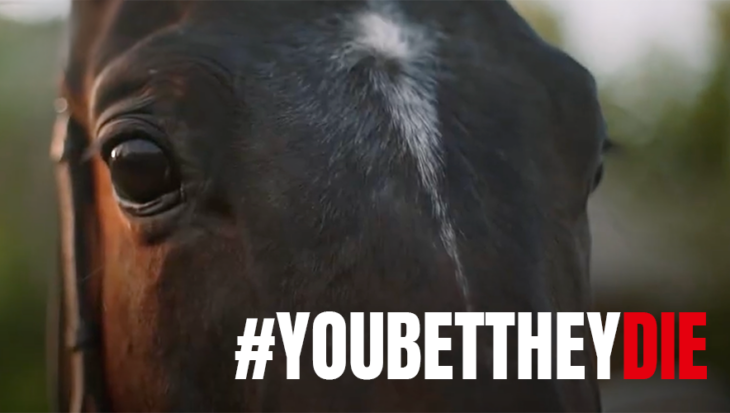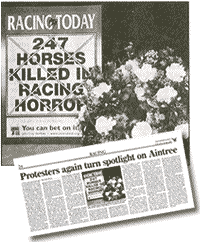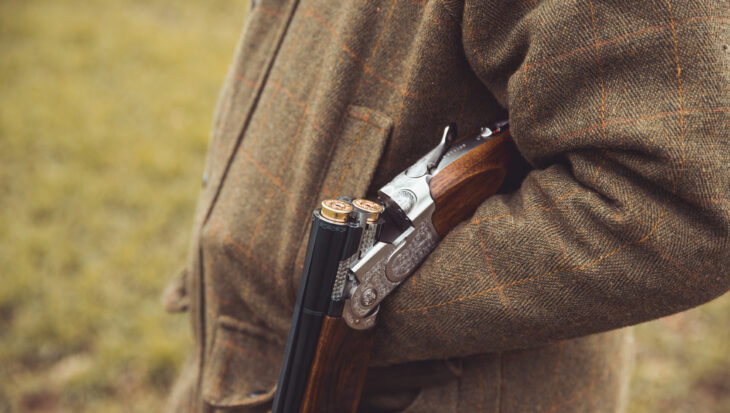After a stop-start season and the abandonment of the Cheltenham Festival, most racegoers and punters are eagerly anticipating the start of the the Grand National meeting at Aintree next Thursday. For the racing authorities, however, yesterday brought a reminder that at this course above all others, controversy is never more than a single incident away.
The grandees at Portman Square may have felt more puzzled than threatened when a music-hall caricature of a bookmaker, accompanied by animal rights campaigners carrying a wreath, turned up on their doorstep yesterday morning. The activists, from the group Animal Aid, were launching an annual campaign to persuade punters to boycott the Grand National, a call which, to judge by the £70m or so bet on the race last year; has not been heeded by many backers.
Yet after a series of fatalities at recent National meetings, including that of the popular chaser One Man in 1998, the organisers will be acutely aware that their event attracts public scrutiny like no other. Last year, five horses were killed at the meeting, four of them on the opening day, prompting the Jockey Club to mount an internal investigation into possible links between the deaths. It concluded that no common factor existed.
Animal Aid is also taking its campaign against racing in general, and National Hunt racing in particular; on to the internet. The organisation’s web site (www.animalaid.org.uk) lists the names of 247 horses which it claims were “raced to death” during the 1999-2000 jumps season. Of these, 91 were put down on the course, while of the remaining 156, 58 are said to have died away from the track as the result of a racing injury, and 98 simply to have died “prematurely”.
The language used about racing on Animal Aid’s website is often lurid. Describing the death of Architect, in last year’s Glenlivet Hurdle, it says that the vet “put a .320 calibre pistol to the four-year-old’s forehead, ripping a bullet through his brain and spinal cord”. A green screen was put up around the horse “to shield the thousands of punters from the consequences of their ‘harmless flutter’. Many were already piling on the bets for the next race.”
Emotive thought the language is, however, the figures produced by Animal Aid make for uncomfortable reading, and so too the long list of horses’ names, some familiar, others not, which scrolls on a permanent loop across the top of its website.
The organisation compiled its list from the official scratchings – carrying the blunt epitaph “all engagements (dead)” – which appear each week in the racing press. There is thus no doubt that the horses concerned are dead.
However, Animal Aid has also made several assumptions to arrive at its total of 247 horses “raced to death”, with varying degrees of justification. For instance, it assumes that horses which pulled up lame on a racecourse outing shortly before appearing in the scratchings had been put down as a result of a racing injury. More contentiously still, it is assumed that young horses listed as dead with no clear evidence of a racing injury had succumbed “prematurely” as a results of “injury, lack of ability,” or some other racing-related factor.
None the less, Animal Aid’s breakdown is one of the few analyses of racehorse fatalities currently in the public domain. The Jockey Club keeps a record only of the number of horses killed at a racecourse and not of those which die elsewhere. When a horse is scratched, incidentally, a trainer needs only to inform Weatherbys, racing’s administrative arm, of it’s death, rather than the cause.
“The number of horses killed racing last year from 1 January to 31 December was 176,” John Maxse, the Jockey Club’s spokesman, said yesterday.
“That number has been dropping each year in recent years, and is from a total of more than 78,000 starts by horses. Injuries and conditions which result in horses having to be put down off the course have so far proved impossible for us to monitor closely. There are any number of conditions which can result in a horse having to be put down, the vast majority of which are not exclusive to racing in any way at all.”
This relative lack of detailed analysis, however, seems to have provided a vacuum which Animal Aid is more than willing to fill. The adherence of this and similar organisations to an agenda of animal rights – as opposed to animal welfare, which many often mistakenly see as the other side of the same coin – means that its opposition to racing will continue. Its objection is philosophical – that horses are pressed into racing and have no choice but to risk life and limb for the pleasure and profit of others.
For years, the Jockey Club’s reaction to such arguments has simply been to hope that they will go away, but its approach may now be changing. “I think that racing in the past has always been frightened to talk about welfare issues,” Maxse says, “and becomes almost automatically defensive. We need to try and break that habit, because racing has very little to hide in my book. Animal Aid are concentrating on the number of horses who have died, but that doesn’t take into account the thousands of horses who have enjoyed a quality of life which far exceeds that of virtually any other domestic animal in the country, and that is thanks to racing.
“There’s no doubt that we ask a lot of our horses, but in return they enjoy a life which is closer to what they have been bred to do than any other animal can claim to have, with a level of care and veterinary treatment better than any other animal can claim to have.”
The moral argument will continue, but if the Jockey Club is now prepared to engage its opponents, the ongoing attentions of groups such as Animal Aid can be seen as no bad thing. The hope that there will be no serious injuries or deaths at Aintree, meanwhile, is something about which everyone can agree.


